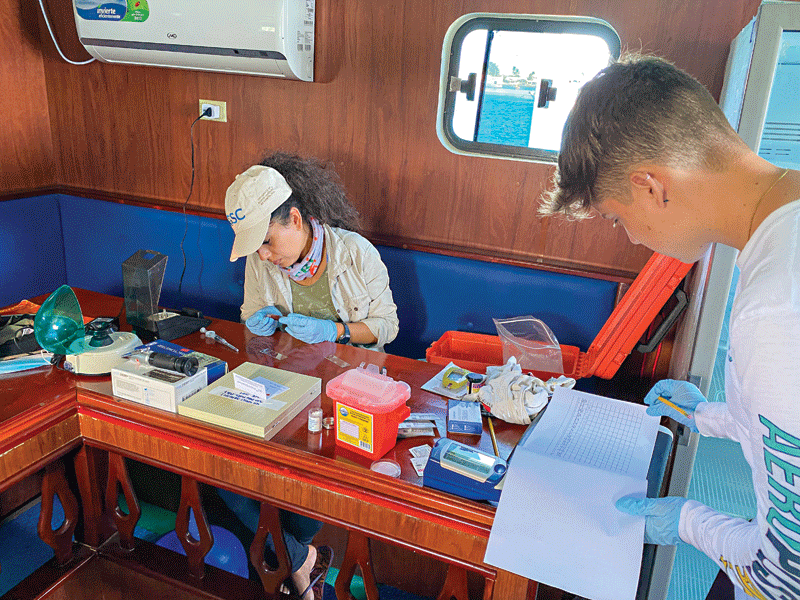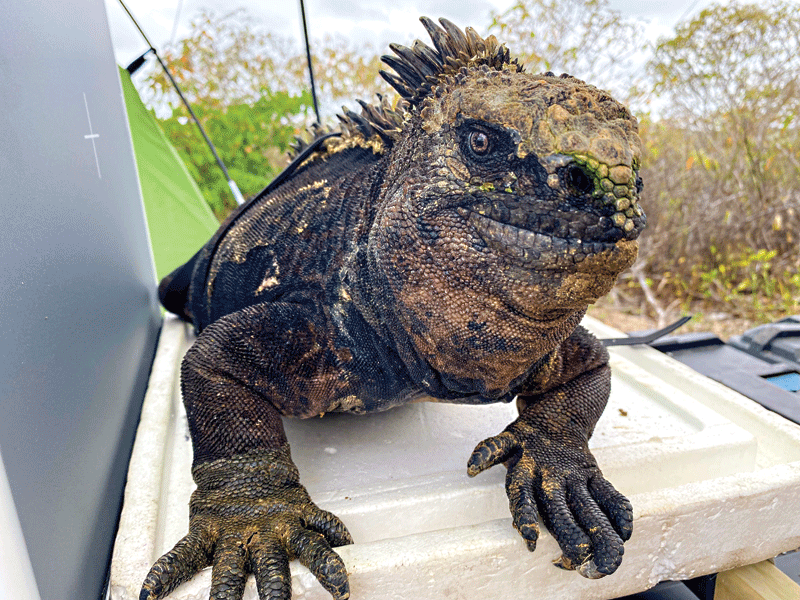
Photos courtesy GA Lewbart
In June of 2013, our team embarked on the first of what would be many projects investigating the health of Galápagos wildlife. With a permit from the Galápagos National Park (PNG) and the support of the Galápagos Science Center (GSC), a small NC State College of Veterinary Medicine (CVM)/University of North Carolina (UNC) Chapel Hill-led team completed a two-day health assessment of 28 green turtles (Chelonia mydas) and a single hawksbill turtle (Eretmochelys imbricata).
While waiting for our research permit and our aviso de campo (field permit) to be finalized, we had almost a week to explore the island of San Cristóbal and think about projects related to wild animal health and welfare. Literature searches turned up hundreds of articles on wildlife anatomy, physiology, ecology, evolution, natural history, ecology, genetics, and invasive species eradication. The veterinary literature was limited to about five dozen, mostly avian-focused publications. Very little work addressed health and diseases of invertebrates, fishes, and reptiles, so we decided these would be good taxa to focus our efforts on over the coming years.
To date, we have published baseline health assessments of 15 species, with seven more manuscripts in review or preparation. A number of other projects related to wildlife health, anatomy, physiology, behavior, and ecology have been undertaken and, in some cases, published.
Building relationships
With 97 percent of the land mass under the jurisdiction and protection by the PNG, establishing good relations with the organization is paramount to working with Galápagos wildlife. For foreign scientists, it is essential they establish strong collaborations with Ecuadorian scientists based in Galápagos.

Over the years, our team has worked to develop data sheets and checklists to make sure we have everything we need. In some cases, we are very remote and not connected to the outside world, except by satellite phone for safety. This disconnectedness had forced us to be self-sufficient with the appropriate backups and duplicity—sometimes, two or three key pieces of equipment and extra supplies.
Animal capture and handling
The protocols and logistics for each species type is different. Sharks, rays, and bony fishes are generally captured with nets and handled quickly and efficiently to minimize stress and morbidity.
The diminutive lava lizard (most are 15 to 30 grams) is captured using a monofilament (fishing line) snare at the end of a long pole or fishing rod. Marine iguanas and land iguanas are captured by leather-gloved hands of three to five researchers working in teams.
Sea turtles are captured by hand using mask, fins, and snorkels and either processed on a boat or on the beach. Seabirds are generally captured by hand, or with a large net, while on their nest. Care is taken not to capture birds with very young chicks or eggs since these are vulnerable to the kleptoparasite frigatebirds. Tortoises are, well, just picked up.
Sample collecting, storage, and analysis
Our work requires a variety of sample types and methods. Samples include blood, blubber, feathers, feces, hair, parasites, skin, and swabs. In some cases, specialized tools or instruments are required, and if the procedure involves entering the animal’s circulatory system or integument, sterility and good hygiene are a priority.
For most studies, we are analyzing samples and collecting data in the field using specialized, portable equipment. Unused field samples are usually stored in a cooler until they can be appropriately analyzed or permanently stored in the GSC. Depending on the sample and type of analysis, samples might be dried, fixed in ethanol or formalin, frozen, placed in specialized media, or simply kept refrigerated. Some samples require analysis on mainland Ecuador or in another country and these samples are stored and transported when appropriate and after proper permitting.
Interesting findings

These are some of the most interesting things we have learned during our research in Galápagos:
- Marine iguanas have blood sodium levels that can reach over 200 mEq/L, the highest of any non-fish vertebrate.
- Pink land iguanas are pink because they lack melanin and possess a confluence of dilated blood vessels just beneath their skin, making them appear pink.
- Many marine iguanas ingest rocks, sometimes up to 30, which may aid in nutrition by helping to grind up plant cells (they consume almost entirely marine algae).
- Sea lions, on at least two islands, can be infected with the canine heartworm (Dirofilaria immitis).
- There is a hybrid iguana (cross between a male marine iguana and a female land iguana) on one small island (discovered in 1997). Its blood sodium is almost exactly between the mean of the land iguana and marine iguana.
- Working with the GNP, Agency for Regulation and Control of Biosecurity and Quarantine for Galápagos (ABG), and the university of Georgia, we identified a pentastome (crustacean) parasite in a confiscated tortoise. This is the first such occurrence in Galápagos and in a tortoise anywhere in the world.
- Marine iguanas have a novel Anaplasma species that is most likely transmitted by Amblyomma darwini, a tick unique to Galápagos lizards, and one that is able to survive up to an hour in the marine environment.
- The ocular trematode, Philophthalmus zalophi, causes severe inflammation in juvenile sea lions by attaching to and feeding on the conjunctiva.
The work our team is doing in the Galápagos is important for many reasons related to animal and human health and well-being. We have established collaborations with regional scientists and students that have helped to build local capacity and empower Galápagueños to develop health assessment protocols, monitor disease trends, and apply high standards of veterinary medicine and diagnostics to benefit wildlife, domestic animals, and people.
Through this process, we have been able to engage over 150 United States students, veterinarians, and other scientists with the Galápagos, building an understanding and appreciation for the archipelago, its citizens, wildlife, and other natural resources. The work we do must be done in the Galápagos, and mostly in the field, as there are virtually no endemic species under human care outside of the Galápagos (either in laboratory, aquarium, or zoo environments).
Olivia A. Petritz, DVM, DACZM, graduated from Purdue University, and then completed several internships and a residency in the field of zoo and exotic animal medicine. She became a diplomate in the American College of Zoological Medicine in 2013 and specializes in zoological companion animals (exotic pets). Dr. Petritz started an exotics service at a specialty hospital in Los Angeles following her residency, and currently is an assistant professor of avian and exotic animal medicine at North Carolina State University.
Gregory A. Lewbart, MS, VMD, Dipl. ACZM, ECZM (zoo health management), has a bachelor’s in biology from Gettysburg College, a master’s in biology with a concentration in marine biology from Northeastern University, and a VMD from the University of Pennsylvania School of Veterinary Medicine (1988). Dr. Lewbart worked for a large wholesaler of ornamental fishes before joining the faculty at the North Carolina State College of Veterinary Medicine in 1993, where he is professor of Aquatic, Wildlife, and Zoological Medicine. Lewbart is a diplomate of the American College of Zoological Medicine and the European College of Zoological Medicine
